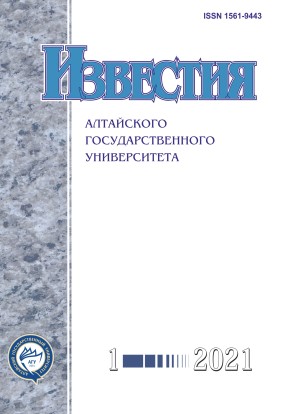Mathematical Models and Machine Learning Algorithms in the Diagnosis of Complications of Type 1 Diabetes Mellitus
УДК 519.8:616.379
Abstract
The paper deals with the problem of diabetic polyneuropathy diagnosing. This is one of the earliest and most dangerous complications of diabetes among children and adolescents. The research aims to develop models for diagnosing diabetic polyneuropathy in children and adolescents based on various medical data. The developed models will make it possible to diagnose a complication without using neurophysiological research methods. Therefore, the proposed models can be used in small medical and obstetrical stations in rural areas as well as a support system for making medical decisions. In the course of the study, a review and analysis of scientific publications of domestic and foreign scientists on the topic of the research are carried out. A large set of textual medical data is processed, then a database is created, features are analyzed, and a model is developed to reveal the presence of diabetic polyneuropathy in children and adolescents with type 1 diabetes mellitus. The achieved quality of the classification model allows us to assert that machine learning methods can be used to find hidden dependencies in the development and course of complications of diabetes mellitus.
Downloads
Metrics
References
Дедов И.И., Кураева Т.Л., Петеркова В.А., Щербачева А.Н. Сахарный диабет у детей и подростков. М., 2002.
Алимова И.Л. Диабетическая нейропатия у детей и подростков: нерешенные проблемы и новые возможности // Российский вестник перинатологии и педиатрии. 2016. № 3. DOI: 10.21508/1027-4065-2016-61-3-114-123.
Алимова И.Л., Лабузова Ю.В. Диабетическая полинейропатия у детей и подростков // Российский вестник перинатологии и педиатрии. 2009. № 6.
Turkyilmaz H., Guzel O., Edizer S., Unalp A. Evaluation of polyneuropathy and associated risk factors in children with type 1 diabetes mellitus // Turk J. MedSci., 2017. Vol. 47. DOI: 10.3906/sag-1601-183.
Bjerg L., Hulman A., Charles M., Jorgensen M.E., Witte D.R. Clustering of microvascular complications in Type 1 diabetes mellitus // J. Diabetes Complications. 2018. Vol. 32. DOI: 10.1016/j.jdiacomp.2018.01.011.
Qin L., Niu J.Y., Zhou J.Y., Zhang Q.J. et al. Prevalence and risk factors of diabetic peripheral neuropathy in Chinese communities // Zhonghua Liu Xing Bing XueZaZhi. 2019. Vol. 40. DOI: 10.3760/cma.j.issn.0254-6450.2019.12.014. (in Chinese).
Fitri A., Sjahrir H., Bachtiar A., Ichwan M., Fitri F.I., Rambe A.S. Predictive Model of Diabetic Polyneuropathy Severity Based on Vitamin D Level // Open Access Maced J. Med Sci. 2019. Vol. 7(16). DOI: 10.3889/oamjms.2019.454.
Krotova O.S., Moskalev I.V., Nazarkina O.M., Khvorova L.A. Diagnostics of Diabetic Polyneuropathy in Children and Adolescents Using Data Mining Methods // Journal of Physics: Conference Series. 2020. Vol. 1615. DOI:10.1088/1742-6596/1615/1/012015.
Рашка С. Python и машинное обучение. М., 2017.
Вьюгин В.В. Математические основы машинного обучения и прогнозирования. М., 2013.
Izvestiya of Altai State University is a golden publisher, as we allow self-archiving, but most importantly we are fully transparent about your rights.
Authors may present and discuss their findings ahead of publication: at biological or scientific conferences, on preprint servers, in public databases, and in blogs, wikis, tweets, and other informal communication channels.
Izvestiya of Altai State University allows authors to deposit manuscripts (currently under review or those for intended submission to Izvestiya of Altai State University) in non-commercial, pre-print servers such as ArXiv.
Authors who publish with this journal agree to the following terms:
- Authors retain copyright and grant the journal right of first publication with the work simultaneously licensed under a Creative Commons Attribution License (CC BY 4.0) that allows others to share the work with an acknowledgement of the work's authorship and initial publication in this journal.
- Authors are able to enter into separate, additional contractual arrangements for the non-exclusive distribution of the journal's published version of the work (e.g., post it to an institutional repository or publish it in a book), with an acknowledgement of its initial publication in this journal.
- Authors are permitted and encouraged to post their work online (e.g., in institutional repositories or on their website) prior to and during the submission process, as it can lead to productive exchanges, as well as earlier and greater citation of published work (See The Effect of Open Access).








